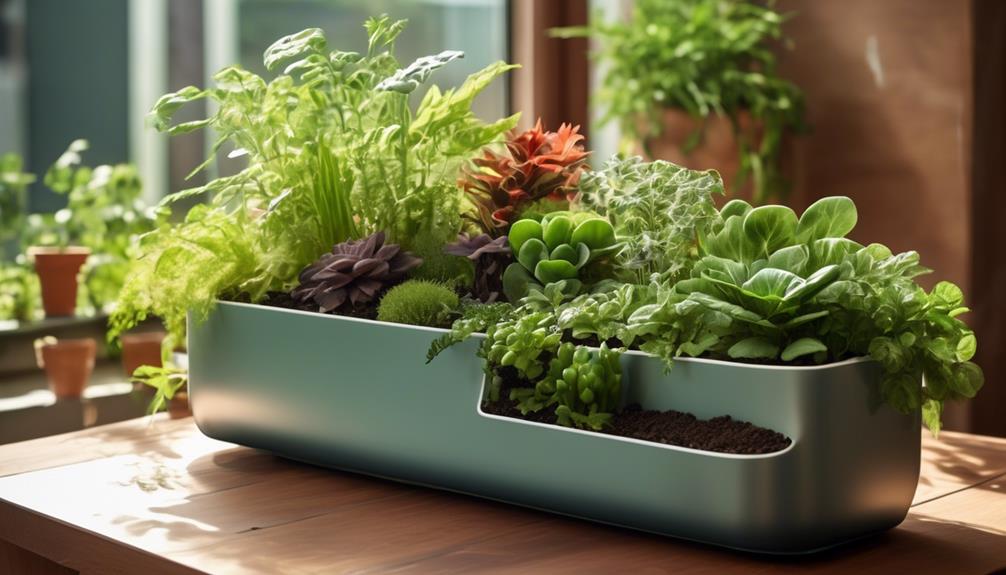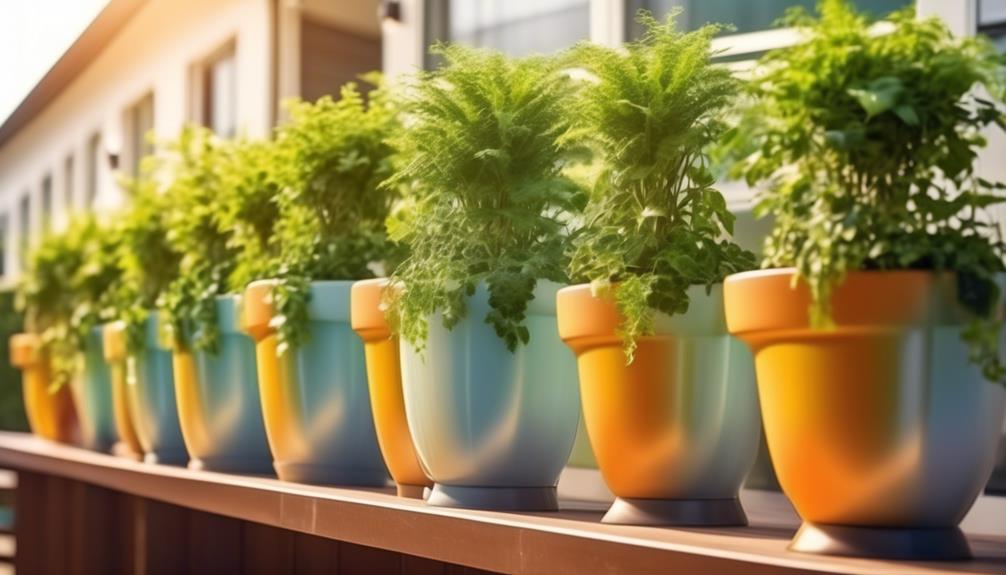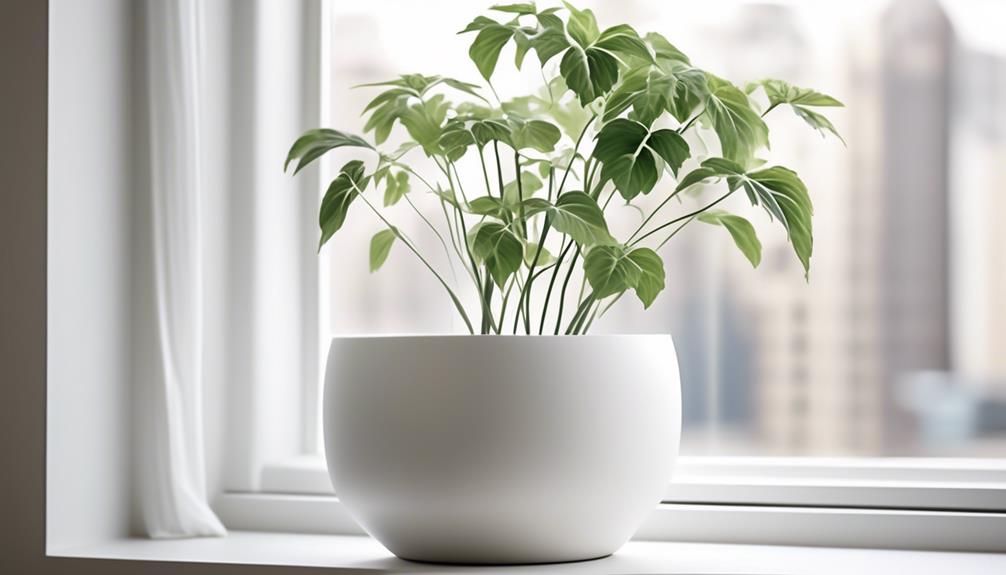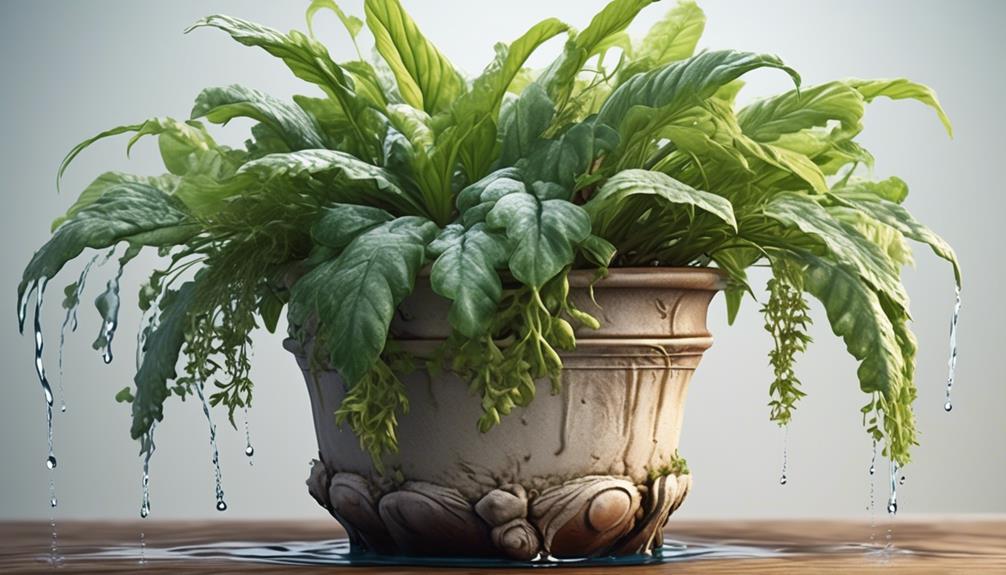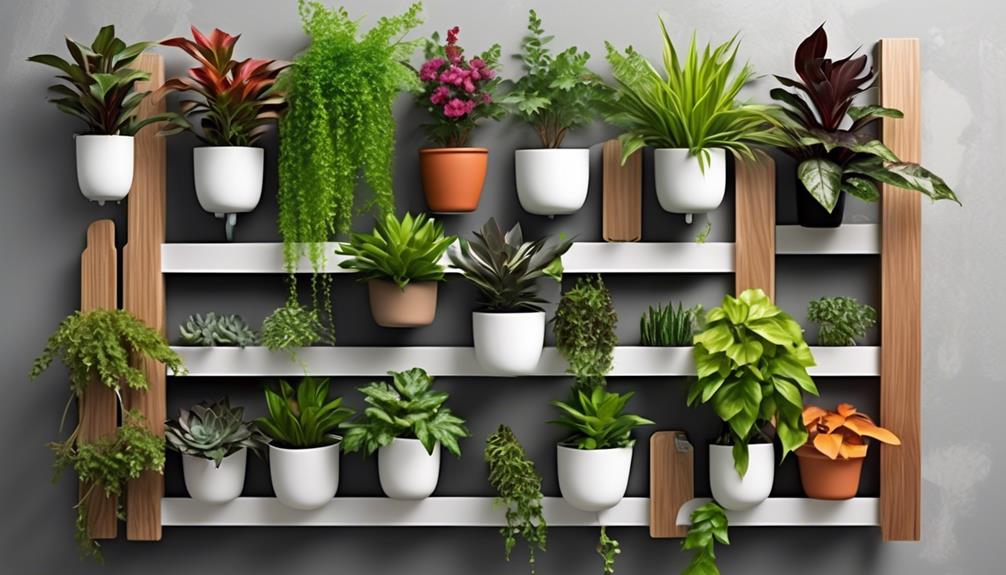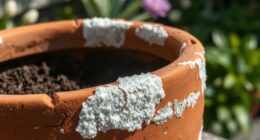As plant enthusiasts, many of us have wondered if self-watering planters truly deliver on their promise of providing an easy watering solution for our beloved plants. Do these contemporary pots truly make watering easier?
The allure of the concept is undeniable, but do self-watering planters really work as effectively as they claim? Join us as we explore the science behind these devices and uncover the truth about their functionality.
Key Takeaways
- Self-watering planters utilize a reservoir of water at the bottom and water is wicked up into the soil through capillary action.
- They provide consistent moisture to plants, preventing overwatering and reducing the risk of root rot.
- Self-watering planters promote healthier root systems and overall plant growth.
- While they may not eliminate the need for regular maintenance, self-watering planters are time-saving and suitable for a variety of plant care needs.
How Do Self-Watering Planters Work?
Self-watering planters work by utilizing a reservoir of water at the bottom of the planter, which is then wicked up into the soil through a capillary action to provide consistent moisture to the plants. This mechanism ensures that the plants receive water as and when required, maintaining an optimal moisture level. One of the key benefits of this system is its ability to prevent overwatering, which is a common issue in traditional planters. By allowing the plants to draw water as needed, the self-watering mechanism promotes healthier root systems and reduces the risk of root rot.
However, despite the advantages, there are some drawbacks to consider. While the self-watering system reduces the frequency of watering, it doesn't eliminate the need for regular maintenance entirely. The reservoir needs to be refilled periodically, and the planter should be checked for any clogs or malfunctions in the watering mechanism. Additionally, certain plants may have specific watering requirements that may not align perfectly with the self-watering system.
Understanding the functioning and maintenance of self-watering planters is essential for harnessing their benefits effectively while mitigating potential drawbacks.
Pros and Cons of Self-Watering Planters

When considering the implementation of self-watering planters, it's essential to weigh their advantages and disadvantages carefully to make an informed decision about their suitability for specific plant care needs.
Self-watering planters offer several benefits, including:
- Consistent Moisture: These planters provide a consistent water supply to the plants, ensuring that they receive the right amount of moisture without the risk of overwatering or underwatering.
- Time-Saving: Self-watering planters minimize the frequency of watering, making them a convenient option for individuals with busy schedules or those who travel frequently.
- Root Health: By allowing plants to draw water as needed, self-watering planters promote healthier root systems and overall plant growth.
However, there are also drawbacks to consider, such as:
- Cost: Self-watering planters can be more expensive than traditional planters, which may impact budget-conscious individuals or large-scale gardening projects.
- Maintenance Requirements: While they reduce the frequency of watering, self-watering planters require periodic monitoring and maintenance to ensure proper functioning of the watering system.
- Potential for Waterlogging: Improper usage or design flaws in self-watering planters can lead to waterlogging, which can harm plant roots and compromise overall plant health.
Careful consideration of these benefits and drawbacks is crucial when deciding whether self-watering planters are the right choice for specific plant care needs.
Tips for Using Self-Watering Planters Effectively
To effectively utilize self-watering planters, it's essential to ensure proper placement and adequate monitoring of the water reservoir levels to support optimal plant growth and health. When using self-watering planters, it's crucial to consider the watering frequency and soil moisture.
The frequency of watering will depend on factors such as the plant selection and container size. Different plant species have varying water needs, so it's important to select plants that are suitable for self-watering systems. Additionally, the size of the container will influence the amount of water available to the plant. It's important to choose a container size that matches the needs of the specific plant to avoid over or under-watering.
Monitoring soil moisture is also critical for effective use of self-watering planters. Checking the soil regularly can help in adjusting the watering frequency and preventing issues related to overwatering or underwatering. By maintaining the right soil moisture levels, plants can thrive and remain healthy in self-watering planters.
Properly utilizing self-watering planters involves understanding the water needs of the plants, selecting the right container size, and monitoring soil moisture to support optimal plant growth.
Common Misconceptions About Self-Watering Planters
Misconceptions about self-watering planters often arise due to a lack of understanding of their mechanics and capabilities. To debunk myths and provide clarity, it's essential to address some common misconceptions:
- Set It and Forget It: One common misconception is that self-watering planters require no regular attention. While these planters do reduce the frequency of watering, they still need occasional monitoring to ensure the water reservoir is adequately filled.
- One Size Fits All: Another myth is that all plants thrive in self-watering planters. In reality, different plant species have varying watering needs, and it's crucial to consider the specific requirements of each plant when using these planters.
- Elimination of Overwatering: While self-watering planters minimize the risk of overwatering, they don't entirely eliminate it. It's still essential to be mindful of the watering frequency and adjust it based on the plant's needs and environmental conditions.
Understanding the mechanics and limitations of self-watering planters is crucial for effective usage. By dispelling these misconceptions, individuals can make informed decisions about the watering frequency and plant suitability when utilizing self-watering planters.
Real-Life Experiences With Self-Watering Planters
Addressing common misconceptions about self-watering planters, our real-life experiences with these innovative systems have provided valuable insights into their practical use and effectiveness.
When using self-watering planters, it's crucial to have realistic expectations. Our experience has shown that while these planters can significantly reduce the frequency of watering, they may not eliminate the need for occasional manual watering, especially during periods of extreme heat or prolonged drought. Understanding the limitations of these systems is essential for successful use.
Additionally, we've found that proper setup and maintenance are crucial for optimal performance. Troubleshooting tips such as regularly cleaning the watering mechanism and ensuring proper drainage are essential for preventing issues such as waterlogging or uneven distribution of moisture. Moreover, choosing the right soil mix is paramount to ensure that the wicking action functions effectively.
Through our experiences, we've learned that self-watering planters can be highly effective when used in conjunction with attentive care and maintenance, and when realistic expectations are maintained.
Frequently Asked Questions
Can Self-Watering Planters Be Used for All Types of Plants, Including Succulents and Cacti?
Yes, self-watering planters can be used for all types of plants, including succulents and cacti. Succulent care requires less frequent watering, and self-watering planters can help maintain the optimal watering frequency for healthy plant growth.
When container gardening, it's essential to consider the specific watering needs of different plants. Whether it's indoor or outdoor plants, self-watering planters provide a convenient and effective way to maintain plant health.
Do Self-Watering Planters Require Any Special Maintenance or Cleaning to Prevent Mold or Algae Growth?
We've found that preventing mold and algae growth in self-watering planters requires regular cleaning and maintenance. It's essential to keep the reservoir and wicking system clean to ensure optimal plant health.
Using the right type of planter for indoor gardening can also minimize these issues. Regularly checking the water level and cleaning the planter according to the manufacturer's recommendations are key for a successful self-watering system.
Are Self-Watering Planters Suitable for Outdoor Use in Extreme Weather Conditions, Such as Heavy Rain or Intense Heat?
Yes, self-watering planters are suitable for outdoor use in extreme weather conditions. They're designed to withstand heavy rain and intense heat, providing excellent outdoor durability.
When it comes to plant compatibility, succulents and cacti thrive in self-watering planters, as they require minimal watering and well-draining soil.
These planters offer a scientific approach to maintaining plant health in outdoor environments, making them a great choice for extreme weather conditions.
Can Self-Watering Planters Be Used in Conjunction With Traditional Watering Methods, Such as Manually Watering the Soil?
Yes, self-watering planters can be used in conjunction with traditional watering methods.
The benefits of self-watering planters include consistent moisture levels and reduced water waste.
They can complement existing watering systems, providing a backup during dry spells or when manual watering is desired.
Are There Any Specific Types of Soil or Fertilizer That Should Be Used With Self-Watering Planters to Maximize Their Effectiveness?
When it comes to the best fertilizer and ideal soil mix for self-watering planters, it's essential to consider the specific needs of the plants you're growing. Different plants require different nutrients, so it's important to choose a fertilizer that aligns with their requirements.
Additionally, using a well-draining soil mix can help prevent waterlogging and root rot, maximizing the effectiveness of self-watering planters.
This attention to detail can significantly impact the success of your plants.
Are Self Watering Planters an Effective Way to Keep Plants Hydrated?
Self watering planters are an effective way to keep plants hydrated, especially for busy individuals or those who tend to forget to water their plants regularly. The self watering plants effectiveness stems from the reservoir system that allows the plant to draw up water as needed, keeping the soil consistently moist.
Conclusion
In conclusion, self-watering planters do work effectively. They provide a consistent and regulated water supply to the plants, promoting healthy growth and reducing the risk of over or under watering.
They offer convenience and efficiency, making it easier to maintain a thriving garden. With proper usage and understanding of their benefits, self-watering planters can be a game-changer for plant care, ensuring lush and vibrant greenery in any space.

